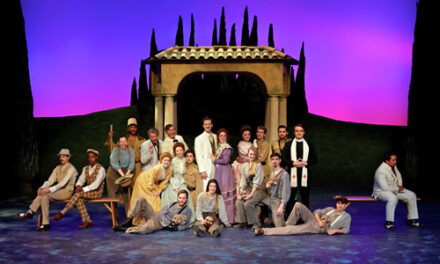Are we living in a golden age of violinists? Some might have thought that after Heifetz, Milstein, Oistrakh, Menuhin, Stern and other 20th century masters stopped playing, truly great successors would take a while to emerge. But Perlman and Zukerman arrived, then Kennedy, and then a host of younger stars (many of them women — Sarah Chang, Midori, Hilary Hahn, Anne Akiko Myers, Anne-Sophie Mutter) started their dazzling careers.
And so did Joshua Bell.
Not yet 45, Bell is at the forefront of concert violinists, and he showed why before a nearly full Meymandi Concert Hall audience in a special North Carolina Symphony program devoted to works about the British Isles. About the only thing missing at the end of his performance was the entire audience standing in the seats and whistling approval.
The entire concert was lovely from start to finish. Music director Grant Llewellyn led the symphony through two English pieces; Gustav Holst’s Suite No. 1 in E-flat major, Op. 28, No. 1, and Edward Elgar’s Serenade in E-minor for string orchestra, Op. 20, along with Mendelssohn’s recreation of the rocky Scottish coast, the Hebrides Overture (“Fingal’s Cave”), Op. 26.
The Holst piece, one of two scored for “military band,” sounds just fine played by a full symphony orchestra. The melody in the initial chaconne builds to a stirring climax after a series of thematic statements and repeats, and the symphony’s brass and winds, especially the lower horns, provided substance and depth to the sound. The lively intermezzo, which is based in part on the opening melody line, recalls folk tunes and contains a nice trumpet solo. The final march, also based on the opening melody, seems like such a typical British march in structure and instrumentation, and one is hard-pressed to keep feet from tapping in time.
A different kind of English musical “feel” came with the second piece by Elgar. Here is a more pastoral musical setting, and the symphony strings gave the piece a gorgeous reading, providing a velvet sound to one of Elgar’s smaller-scale, yet still best-known, works. Concertmaster Brian Reagin offered a nice light solo passage in the opening allegro piacevole that was echoed by the full string ensemble. The slower, more contemplative larghetto received a highly emotional reading, in contrast to the final allegretto movement, which carried more of a feeling of urgency. The players never lost their sense of melodic thread, even at the end, which, curiously, sounds as if the composer got sidetracked while composing and subsequently left out a few bars.
Mendelssohn’s popular “Fingal’s Cave” overture starts with the sound of a gathering storm and proceeds with vigorous scoring, mainly for strings, that evokes harsh weather and rugged landscape, and the orchestra served this up quite well, with Llewellyn’s precise conducting moving things right along. As in the two earlier pieces, the symphony played with a clarity and transparency, plus fine dynamics that were most enjoyable to hear.
Bell took over the second part of the program with Bruch’s Scottish Fantasy for violin and orchestra, Op. 46, and the collaboration between soloist and orchestra on this package of pure melody was tremendous. Bell had complete mastery over the music and his lovely Stradivarius violin, and Llewellyn and the symphony players provided excellent support.
Bell’s tone was so pure and clear throughout the piece that at times one wondered how he does it. How does he play such high notes (at least two octaves above normal, with his fingers moving so far up the neck that his bow almost touches his fingertips) and not produce tinny, or tiny, or dry, or scratchy sounds? Bell also “plays well with others,” forming a nice dialogue with the flute in the second allegro movement, engaging in several duets with harpist Anita Burroughs-Price and exchanging phrases with the entire orchestra.
The piece ranges from vigor to delicacy and bac k— frequently — and Bell’s energy and attention never flagged, and he was especially robust in the familiar final movement, based on “Scots wha hae.” His fingering was magic, his double-stops effortless, and he overpowered neither the score nor the orchestra players.
Continuous applause brought him back for an encore, Henri Vieuxtemps’ “Souvenir d’Amerique,” or variations on “Yankee Doodle Went to Town,” which might be Bell’s signature closer. This version could be called “Bell’s Variations on Vieuxtemps’ Variations,” and all the strengths and skills he brings to a concerto-like piece were fully exposed in this dazzling solo, including a terrific pizzicato section. One hesitates to say that a single musical performance causes the jaw to drop, but….











